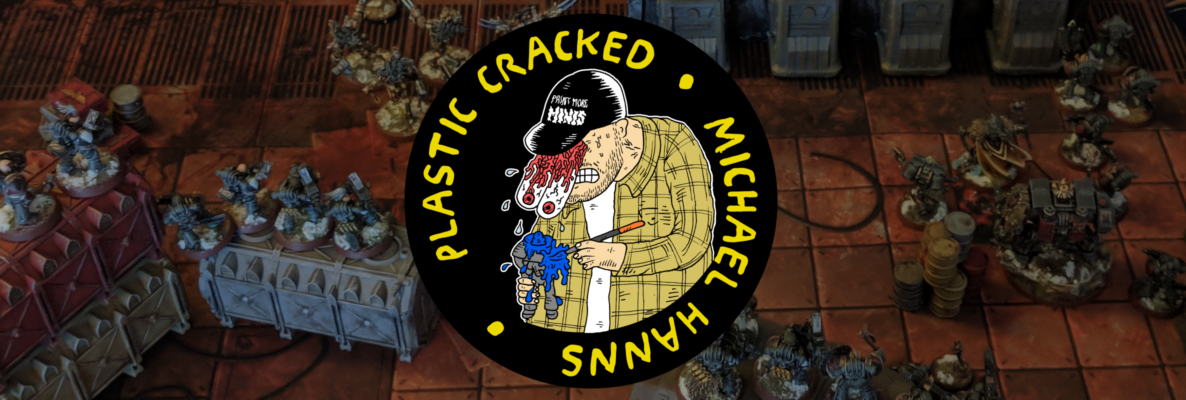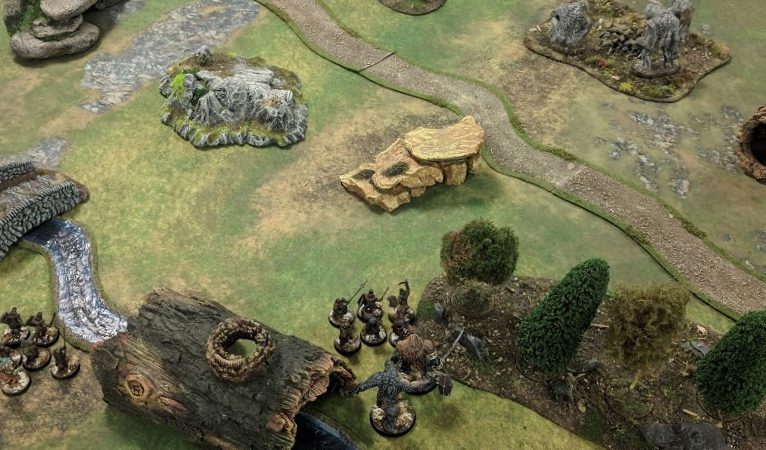
January has come and gone, and thus far the Middle-earth SBG has enjoyed a total domination over my hobby focus. I’ve got an absolute slew of new models to talk about, including a whole new SBG mini project – although after the somewhat epic (read: long-winded) length of my post-Christmas post, I’m going to do my best to try and keep this one a little shorter and more focussed on my grab-bag of Evil additions and give my Good their own post later.
LETS GET TO IT!
Following immediately on the tails of my first Angmar expansion, I decided to double down until I had solid coverage over the entirety of the Angmar army list – very similar to how I left my Rivendell Elves following round II of their expansion1. In order to fully cover the roster of profiles in the list, I would need to get me some Warg Riders, and Gûlavhar, the Terror of Arnor. Having just blasted through a number of heroes and monsters, I opted to work on the Warg Riders first.

First things first, let’s talk about the build. If you look even a little closely to the above photo you’ll likely notice that there are 8 Warg Riders and 4 Wargs in the photograph. When researching this kit, I discovered the Warg Rider frame doesn’t come with a lot of options – there are 6 Wargs, buildable with Riders or without. Each rider can have an optional Shield, but beyond that their load outs are 2x Throwing Spear, 2x Sword and 2x Bow. While Cavalry Archery are always kind of a novel idea to play around with, everything about these guys works against giving them a bow – they’re not Expert Riders, meaning they won’t get the +1 defence bonus from bringing a Shield if you give them a bow. On top of that, the already impressively bad shoot value of 5+ on an Orc becomes particularly unreliable when they’re on the move – kind of defeating the point in light Cavalry such as this.
My original plan for my Warg Riders was going to be one box of Cavalry to the army and that would be that (much like my Rivendell Knights), perhaps with the added complication of magnetising the riders as Wargs will occasionally stick around after their master has been slain. I really wasn’t super jazzed about having 1/3rd of them swap their shield for a bow however, and after bouncing about the idea in my head of finding a second frame of mountless riders on eBay or something, I came to the conclusion that Middle-earth plastics are cheap enough just to justify getting a pair of boxes, building the useful Warg Riders and leaving the remaining 4 Wargs for Dismounts.
The Warg Rider kit is a pretty simple build mostly, with two part Wargs and mostly single piece Riders with a shield to stick on to finish. One massive pitfall however of these slightly dated plastics is that the Wargs glue together absolutely horribly and leave some really noticeable gaps across the neck (example here), along with having something of a flat butt. The former I caught during building and was fixed relatively easily with a little creative green stuff coverage, though the latter I only noticed after I finished painting my first four riderless Wargs, and went back over with some green stuff before continuing on with the rest.
I honestly can’t decide if these miniatures were fun to paint or not. There were a lot of ups and downs in the process. It’s extra infuriating to find out that each Cavalry model requires not only an Orc dismount but a Warg dismount as well (whereas Horses will always flee immediately), but on the other hand having four Wargs to paint by themselves before moving onto the Warg Riders really helped with nailing down the process on them, making the Warg portion of the next 8 a lot quicker. I found myself a little dismayed by both the quality of sculpt and lack of pose diversity on these guys when they were unpainted, but I was genuinely satisfied by how much I enjoyed their look when I was finished painting them all the mish-mashed earthtones of the rainbow, and I was left with a very diverse unit with a biege, brown, and green skinned Orc for each rider sculpt. The only real tricky piece of the painting puzzle with these guys – and avoidable if you paint in sub-assemblies or magnetise the riders – is that my method for painting Orcs is very reliant on dusty textured drybrushing and successive washes to temper and blend each, and it can be a bit hard to keep paint off the Rider or the Warg respectively when there’s so much drybrushing and washing going on for each.
As a final point I’ll add for these guys, my basing method was a continuation of the water effects and snow combo that I started on the Ringwraiths, and I’m – as always – extremely pleased with the results. I honestly don’t know what I ever did without those big ol’ texture jars from Vallejo. Thick mud, black lava, brown earth and water texture – they’re all great.
Hey, if anyone from Vallejo is reading this – hook a guy up with an endorsement deal, willya?

Next up was Gûlavhar, the Terror of Arnor. This was a fast model compared to the Warg Riders – looking at the miniature itself, I knew it was going to be a fairly quick job, but it honestly blew me away with how quickly this guy came together.
But I’m getting ahead of myself. The first thing I wanted to say about this model is that it was a great Finecast resin casting. The pieces all came fairly clean, without too much sprue to cut off and very little in awkward or difficult to reach places, and next to none of the little overflow triangles that you have to cut out of overhanging parts2. The whole miniature was put together in a matter of minutes, with very little green stuff gap filling – in fact, I think the only place I used filler at all was on the wing joint, and it was a quick super glue job. The completed miniature feels surprisingly light compared to the absolute solid mass of Buhrdur or even my converted Fell Beast3, though I’m extremely thankful I didn’t have to go to the faff of pinning massive metal wings on this guy. All-in-all, I was really impressed with this Finecast piece which has translated particularly well from it’s original metal version – particularly after all the awkward casting issues I had with my foot/mounted Witch King.
Gûlavhar is kind of an interesting miniature for SBG, in that his long, outstretched wings and tight feet-together perching pose on a singular rock all come together to give him a huge expanse of empty base. This is extremely rare in my experience for SBG, with big bad miniatures like Sauron and Sauron the Necromancer squeezing quite tightly onto little 40mm bases. Cave Trolls and their ilk also squeeze onto fairly small bases, and even the biggest bad of them all – Smaug the Terrible – comes with a pre-cast scenic base that takes up the whole thing. There’s certainly a few upper-mid-sized monsters like the Balrog or Fell Beast with a bit of design space to do something interesting with the base, but Gûlavhar has a wealth of space to make things happen.
I knew I wanted to carry on the spooky green ruins theme that I started on my Fell-Beast conversion, but none of the pieces of Osgilliath Ruins that I had left were really speaking to me. In the end, I decided to break out the Flagstone Green Stuff Roller to press a ruined cobble street around Gulavhars rock, with dirt spilling across bridging a space between a nice large water texture feature. I did this by pressing down a bunch of green stuff on half the base around where I wanted my Gûlavhar’s perch rock to sit. After pressing the texture down, I glued the miniature itself to the base and spread some Vallejo Brown Mud across the base. I added a little Black Lava and a sprinkling of sand in between the green stuff flagstones and the mud to represent the debris and broken stones and other scattered gravel. Once it all dried, I took him outside to prime (just a plain Citadel Chaos Black primer coat, no zenithal) and got started on the paint job.
From a painting perspective, Gûlavhar was dead easy. Look at him, of course he was. Having had a bit of experience painting black, winged monsters with my Fell Beast, I knew this was going to be another exercise in drybrushing and washing in successive layers. I did basecoat his belly and inner arms/thights/neck with a bit of Cold Grey, just like I did the membranes of his wings, but the vast majority was left untouched and drybrushed with Dead Flesh and Heavy Bluegrey in various mixes, sometimes with a little Wolf Grey added when I really wanted certain areas to pop. After drybrushing, I’d wash certain areas down again to try and blend the colours a bit and reduce the chalky textured look of drybrushing. Rinse/repeat about three or four times, and the skin and wings are done. I’m pretty happy overall with how this came out, and I have to say that GW did a terrific job on this sculpt. It really feels like a miniature that was intended to be painted, with deep, visible recesses and textures all over that just respond really well to staple techniques like drybrushing and washing.
Following the body, I tried to get a half decent but subtle blend on his horns in the same blackish tone with a slight Dead Flesh inflection with a few careful glaze layers. To finish up, I painted his claws and teeth in Elfic Flesh with a Seraphim Sepia wash and a highlight of Off-White, while his tongue and gums were painted Screamer Pink with a Reikland Fleshshade wash and a Screamer Pink/Tentacle Pink highlight.
The base was pretty simple, and I applied my standard method of Earth as a base to mud with Mechanicus Standard Grey on the rock, while the green stone was based in Stonewall Grey. The whole base then got an Agrax Earthshade wash. Once this was dry, I drybrushed the rock Heavy Bluegrey and then a lighter pass of Wolf Grey, while the mud got a light drybrush of Earth again. The stone was then washed with Biel Tan green, and I think Seraphim Sepia before another Biel Tan green, and finished with a light drybrushing of Camouflage Green mixed with a little Dead White. After a quick blast of Dullcote to seal the mini, I stuck some tufts and scattered leaf littler on the mud. I used Army Painter Mountain Tuft on the outer edges with Wasteland Tuft closer towards Gûlavhar himself to sort of demonstrate the corruption of his mere presence. Finally, I applied a thick coat of Vallejo Water Texture over the recessed mud on the base and a few dollops of Valhallan Blizzard to finish.
As a final touch, I applied some Blood for the Blood God to his hands, mouth and where his clawed feet might have touched or dripped on the base; as I mentioned on my Fell Beast, this isn’t something I add often to my Middle-earth miniatures, but for creatures like this I will definitely make an exception. With that, Gûlavhar – and my Middle-earth Angmar army – was 100% done and dusted.
So, how do we celebrate finishing up painting a big pile of miniatures? Why, by painting miniatures, of course!
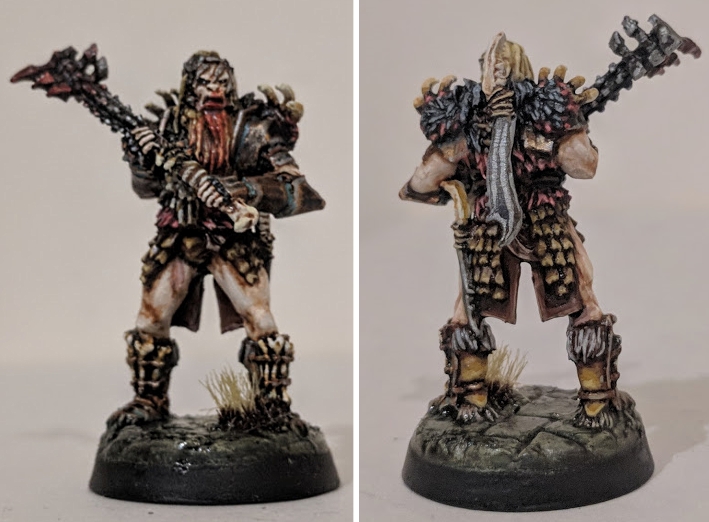
To recap the rough timeline of my Middle-earth miniatures journey, it’s went something along the lines of:
- First batch of Rivendell – basics to build an army
- First batch of Angmar – basics to build an army
- Second batch of Rivendell – filling out characters and missing troop choices
- Sauron the Necromancer and the 9 Nazgul of Dol Guldur
- Final batch of Angmar – collecting all the named characters, and missing troop choices
It was my intention, upon finishing off the rest of my Angmar force to follow up with a Grey Company army, hot on the heels of the new Gondor at War expansion. I had actually made a bit of a start on that project with my Aragorn before Christmas, but I just couldn’t quite get into the headspace to paint 10 kinda samey looking Rangers, and looked at other potential projects. One of those was my Dol Guldur.
The Dol Guldur were a funny little project. Nestled between the waves of expansion for my bigger, more flexible flagship armies was this quick little project that comprised of 10 miniatures. Being mostly ForgeWorld, it wasn’t the cheapest little project for what it was and it just sort of flew in and out like that. Gaming wise, they’re a fairly complicated little force that only really make sense in games of 800-1000 points to boot, which doesn’t really gel with the 500 point demonstration games I’ve been playing with a lot of my friends lately. Still, they were a blast to paint, being extremely quick with gorgeous looking sculpts that were really rather forgiving to work on. But they weren’t really finished. I had completed the project in it’s current state (Sauron and the Nine) a good bit before I picked up the Armies of the Hobbit sourcebook, and as such I wasn’t entirely sure what my options were for expansion, so I wanted to keep my options open.
Turns out, there wasn’t really any options. Sauron and the Nine puts you at about 925 points, leaving only 75 points for a 1000pts army. The list then has two other options: the Keeper of Dungeons, or the Castellans of Dol Guldur. One of these is a square 75pts, the other is 40 points a piece. Without dropping some of the Nine and putting in some allies from Azog’s Legion (something I would like to do somewhere down the line), you pretty much don’t really have a choice at all in the matter. So, that left me with the Keeper of Dungeons.
I wasn’t especially stoked on adding this miniature to my Dol Guldur – I hadn’t (and still haven’t if I’m honest) really read his rules or what he brings to the table, but he really felt a bit like an odd one out in the army. The Nine themselves were monochromatic black and steel, while Sauron was essentially a bigger version of the Nine. Then you’ve got the Keeper of Dungeons who, while unified closely with the Nine in overall stylistic vision4, is ultimately.. just one singular Orc in a warband of Wraiths.
Still, my hands were sort of tied so I bit the bullet and ordered one, and by the time I was finished with him I was extremely glad I did.
First of all, the sculpt is fantastic. It’s easy to fall prey to the trap that oh ForgeWorld is more expensive and fancier but this particular miniature is every millimetre as good looking, if not moreso, than the Nazgul of Dol Guldur. The resin cast was distinctly Finecast however, and required the appropriate amount of cleanup you might expect from the medium, but as far as mould lines and awkward/destructive sprue placings or even those weird, hard to find overhang triangles go I thought this miniature was a snap to build and clean up, with crisp and rich detail popping out at every angle. Top marks to GW there.
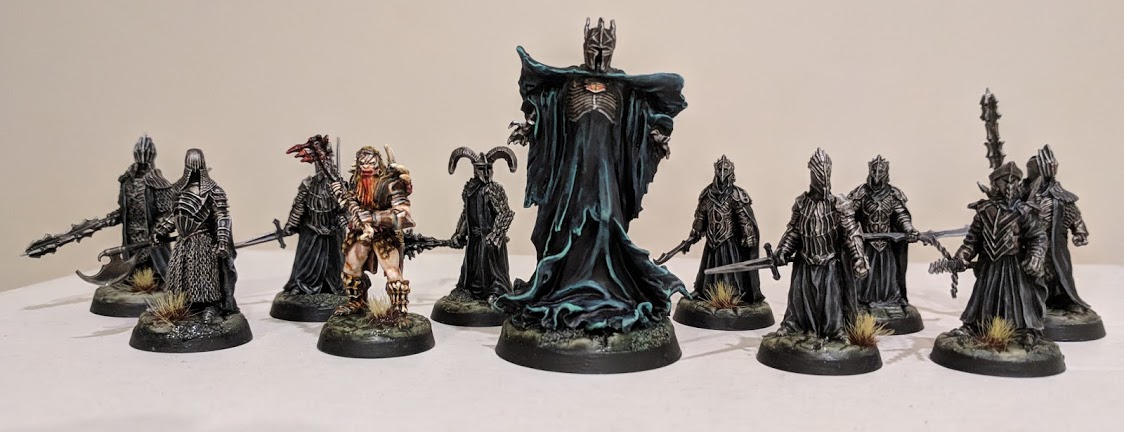
Secondly, as a stand alone little one off project, the Keeper was an awful lot of fun to paint. In the interests of brevity, I won’t go through my entire process (spoiler alert: I used Vallejo Game Colour paints and Citadel washes, and used washes, layering, drybrushing and edge highlighting), but suffice to say he took about as long to paint as the rest of the army combined. Much like Gûlavhar, he as absolutely loaded with nice, crisp details and responds really well to bread and butter miniature painting techniques, with the added bonus of having some nice semi-flat areas to employ a little wet blending and layering. I particularly enjoyed painting his pale Orc flesh, along with building up his dirty blonde beard and then getting a little thinned down Blood for the Blood God on there in a couple of thin layers before the Dullcote to simulate dried bloodstains.
Finally, and probably most importantly.. I was completely wrong about the aesthetic. While the Keeper does stand out in the sea of black and silver, I find he acts more like a spot colour in the army and really draws the eyes. The pale white flesh is almost luminous in the dingy blacks and greenish/grey base, while the red on his armour and the blood in his beard lend a vicious, threatening element to the otherwise cold and bleak blacks and greens of the rest of my Dol Guldur. I’m extremely happy for his addition, and it’s great to completely bring this force together finally.
Last, but far from least, is the last little Evil piece I knocked out in January…
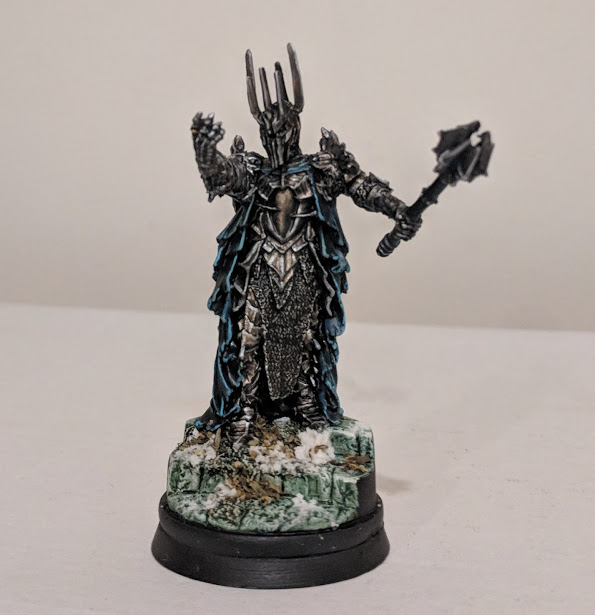
It’s the big bad himself, The Dark Lord Sauron.
Oh man, I have to say, I have really been looking forward to this one. Other than being completely enamoured by The Witch King of Angmar and all the fun and crazy disrupting shenanigans of his personal faction, one of the big draws for me to Angmar was how much of the list was shared between Angmar and Barad Dúr. Each is ultimately defined by a core of classic Mordor Orcs, and supported with Warg Rider cavalry and Trolls (albeit with the former using Cave Trolls, while the latter used much bigger and armoured Mordor Trolls), with Orc Captains and Shamans and banners and the like being interchangeable between the factions. Heck, even the Witch King is usable in both lists. Given my sizeable collection of Rivendell Elves, and how much of my Angmar was repurposable in the Barad Dur list, it felt like a total no brainer to try and pick up Sauron himself.
As far as the paint job goes, there is exactly nothing going on with this miniature that I haven’t already explained on Sauron the Necromancer or Gûlavhar, so I won’t repeat myself in that regard. What I do want to talk about is the repose.
My personal opinion is that out of the box, Sauron is a pretty disappointing miniature. As far as cast, detail or overall aesthetic design goes, I think he’s absolutely awesome, but his pose absolutely puts me to sleep. Yeah, I get that it’s a recreation of the moment Isildur cuts the ring from his finger with the Shards of Narsil – cool enough in theory, but in practice, it blows chunks. Aside from how absolutely wooden the miniature looks in this pose, who the hell wants their awesome 400 point miniature representing The Big Bad That All of This Whole Story is About walking around freeze-framed in the moment he was defeated? It’s dumb. It looks dumb. It feels dumb to use. Something had to be done about it.
Thanks to his overlapping plate armour, long straight body cast in a singular chunk of resin (and thank God we’re not working with metal at this point, right?) with long, hanging robes.. there isn’t really a great deal you can do to his body. So that leaves the head, and the arms. Thankfully, all three of these pieces come unattached, and feature sensible points of articulation to mess with.
I messed with some dry fittings of his arms and played with the concept for a while before making any incisions. His slightly wooden leg/body pose meant that whatever he was doing would have to convey a sense of gravitas and composure rather than anything particularly exerting. After spitballing a few dumb ideas, I decided that “less is more” when it comes to these things, and I worked on reposing his ring arm to look less like an outstretched arm grasping, and more like a show of force – displaying the might of the One Ring for his enemies to behold, while simultaneously gazing into the source of his awesome power himself. This was, as it turns out, super easy – and required only a little cutting at the elbow and wrist, along with a little creative green stuffing to get the shoulder on at the right sort of angle. His neck received a little bit of filing and green stuffing to help the repose sit comfortably. This left only his mace arm – which I wanted to be lowered enough to no longer seem like he was mid-swing but simply brandishing it, perhaps pre-swing but not during. It was here I felt the limitations of my converting ability, as I had intended his mace to be held a little lower than it turned out, but couldn’t find a way to make it look natural and without reconstructing a bit more of his arm in green stuff than I would necessarily be comfortable with. In the end, I think his pose looked pretty good though, and I don’t think the above photo – which was taken with showing off as much of the miniature as possible, including the One Ring on his finger – quite represents how natural it looks in person. C’est la vie.
The final thing I should touch on with this miniature is his scenic base, which was actually a mini plinth from Model Display Products. These guys make a bunch of cool stuff – including the plinth I used for the Tiffany Aching display I made for my fiancé – at an incredibly reasonable cost and I would absolutely use them again for another display miniature in a heartbeat. This particular plinth was very slightly inconvenient for what I wanted it for, being exactly 40mm wide on the little raised rim that the stairs sit on, which is about 2mm too wide for the top of the 40mm base I wanted to put it on. Of course, I could have simply used the piece on it’s own as Sauron’s base, but I magnetise the bottoms of my Middle-earth miniature bases for magnetic transport and storage purposes and drilling a hole wide enough for a 4mm magnet is way too much of a faff. Not to mention I find that solid resin bases have a habit of not playing as nice as a hollow base on any uneven surface – making playing on moulded plastic or carved foamboard terrain a bit awkward. My solution to the issue was no less of a faff however, as I pretty much filed down the rim of the base with a wet emery board until it fit reasonably flush with the top of the base. A faff indeed, but it’s done, and it works, and I’m happy.
And that’s us for this blog entry! With my last batch of Evil miniatures finishing off not one, not two but three completely separate armies, I’m switching gears back to good for a while. As a matter of fact, I’ve just finished off my Grey Company Rangers army, and have plans to work on a few more miniatures for my Rivendell army afterward – but that’s a whole other blog post, which I’ll hopefully have before too long.
As always, thanks for reading, and happy wargaming!
1 The wheels are already in motion for a much smaller round III, following my discovery of some rather excellent third party miniatures for a mounted Gil-Galad and Armoured Glorfindel as well as a very lucky find of a very reasonably priced Lindir on eBay. I’ve even gotten a bit of a running start and polished off a quick version of Armoured Glorfindel to cut down on the tedium of painting dismounts.
2 I swear to God, those parts – very similar to the little spikes on metal castings – I never catch until well into the layering and edge highlighting phase of painting.
3 Though to be fair, this has more to do with all the slate I added to the base to lower the centre of gravity and counterbalance the top heavy wingspan.
4 Both ForgeWorlds sculpts of The Nine and Games Workshops finecast rendition of the Keeper of Dungeons share the same ‘based on the movie’ style in overall sculpt, while Sauron the Necromancer – a much older miniature hailing from an older, pre-Hobbit movie supplement – comes across a little more doofier and more cartoonish in my opinion.
